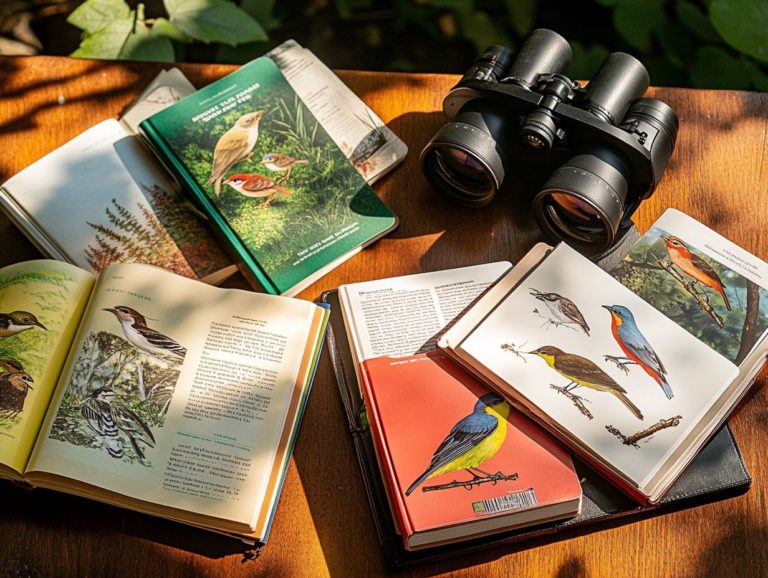Best Field Guides for Birds in Your Backyard
Birdwatching offers a wonderful opportunity to connect with nature, and the right field guide can truly elevate your experience.
This article highlights the foremost field guides for bird enthusiasts, featuring timeless references such as The Sibley Guide to Birds alongside specialized options like The Warbler Guide.
Whether you re just starting out or you ve been birding for years, you ll discover valuable tips for selecting the best guide for your region and enhancing your birdwatching adventures.
Immerse yourself and enrich your bird-related explorations!
Contents
- Key Takeaways:
- 1. The Sibley Guide to Birds
- 2. National Geographic Field Guide to the Birds of North America
- 3. Peterson Field Guide to Birds of North America
- 4. The Kaufman Field Guide to Birds of North America
- 5. Stokes Field Guide to Birds: Eastern Region
- 6. Audubon Society Field Guide to North American Birds
- 7. The Crossley ID Guide: Eastern Birds
- 8. The Warbler Guide
- 9. The Sibley Field Guide to Birds of Eastern North America
- 10. The Kaufman Field Guide to Advanced Birding
- 11. The National Audubon Society Field Guide to Birds: Eastern Region
- 12. The Stokes Field Guide to the Birds of North America
- 13. The Peterson Field Guide to Warblers
- 14. The Sibley Guide to Bird Life and Behavior
- 15. The Kaufman Field Guide to Nature of New England
- What Are the Key Features to Look for in a Field Guide?
- Frequently Asked Questions
- Curious about the best field guides? Here s what you need to know!
- Do I need a field guide to identify birds in my backyard?
- Are there any free field guides available for backyard birds?
- What should I look for in a good field guide for birds in my backyard?
- Can I use a field guide for bird identification in other locations besides my backyard?
- Are there any field guides specifically for children to use in identifying backyard birds?
Key Takeaways:
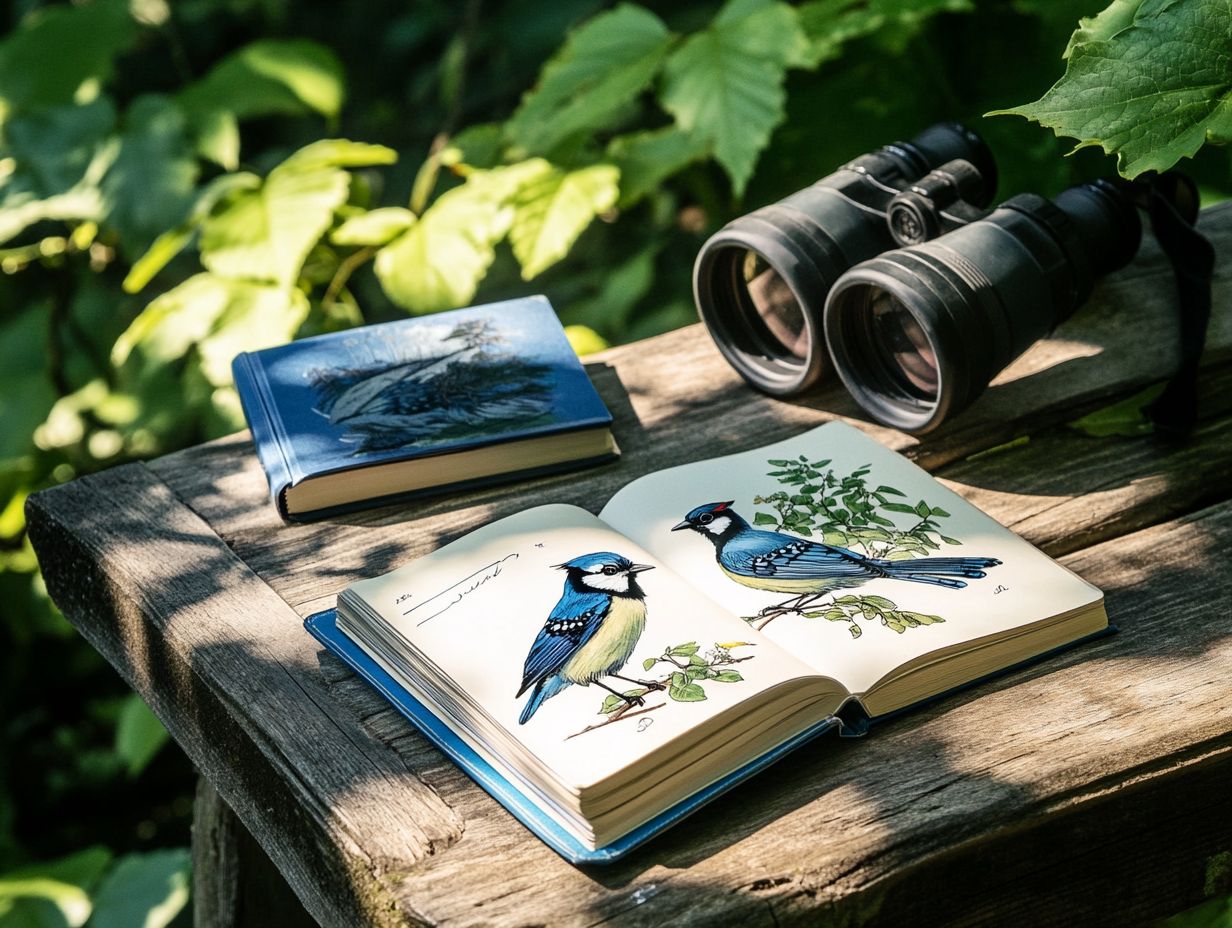
- The Sibley Guide to Birds is a comprehensive and highly acclaimed field guide that covers all North American bird species with detailed illustrations and information.
- The National Geographic Field Guide to the Birds of North America offers stunning photographs and species maps, making it a visually appealing and informative choice.
- The Peterson Field Guide to Birds of North America is a classic and user-friendly guide that includes range maps, song descriptions, and unique identification tips.
1. The Sibley Guide to Birds
The Sibley Guide to Birds is your go-to companion in the realm of birdwatching and identification, crafted by the well-respected ornithologist David Sibley. Whether you’re just starting out or have years of experience, this guide is tailored to meet your needs as you explore North America’s bird wonders.
With its stunning illustrations and informative text, you ll gain invaluable insights into various species, making it a critical resource for your birdwatching adventures.
What truly sets this guide apart is its careful focus on details. It doesn t just showcase the birds; it highlights their distinctive features that help you tell different birds apart, making accurate identification a breeze. The user-friendly layout ensures that you can quickly reference what you need in the field, eliminating the frustration that often comes with bulkier guides.
While other resources may present images that blur the line between species, Sibley’s work enables you to enhance your identification skills with clarity and precision, allowing you to deepen your appreciation and knowledge of bird-related life.
2. National Geographic Field Guide to the Birds of North America
The National Geographic Field Guide to the Birds of North America is celebrated for its stunning photographs and illustrations, equipping you with essential tools to identify a remarkable variety of bird species in their natural habitats, making it a great choice alongside field guides for beginners.
What distinguishes this guide from its counterparts is its comprehensive photographic approach, allowing you to appreciate not just the physical traits of the birds, but also their behaviors in context. With this focus on visuals, you can quickly and accurately identify birds, making every outing an exciting adventure!
The guide also provides insights about the ecology of each species, enriching your birdwatching experience and fostering a deeper understanding of avian environments and conservation issues. To fully maximize its utility in the field, take the time to familiarize yourself with the layout and categorization; this will help you swiftly locate birds even in fast-paced situations.
Ultimately, this guide masterfully blends artistry with science, making it an invaluable resource for both novice and seasoned birdwatchers alike. Don’t miss the chance to enhance your birdwatching experience!
3. Peterson Field Guide to Birds of North America
The Peterson Field Guide to Birds of North America has long been your trusted companion in the world of birdwatching. It offers a seamless approach to species identification with an innovative format and engaging descriptions.
Its groundbreaking use of field marks has transformed how both beginners and seasoned birders connect with the world of birds. Easily recognize over 800 species with this guide, packed with engaging illustrations!
This guide provides detailed descriptions and illustrations that highlight the distinctive traits unique to each bird. Unlike many modern guides that drown you in scientific jargon, this resource is accessible for everyone.
It welcomes eager beginners while delivering valuable insights to experienced birders. Its historical significance shapes contemporary birdwatching literature, ensuring it remains a staple in the backpacks of nature enthusiasts everywhere.
4. The Kaufman Field Guide to Birds of North America
The Kaufman Field Guide to Birds of North America stands out with its innovative layout and emphasis on quick, accurate identification tips. For those looking for additional recommendations, exploring the best field guides for birding makes it an exceptional choice for both novice and seasoned birdwatchers.
This guide offers concise descriptions that emphasize key characteristics, enabling you to easily identify various species in the field. Its intuitive organization, complete with clear visuals and vibrant illustrations, ensures effortless navigation.
Quick reference sections serve as handy tools for immediate assessments. For beginners, this thoughtful design simplifies the identification process and cultivates a deeper appreciation for avian diversity.
5. Stokes Field Guide to Birds: Eastern Region
The Stokes Field Guide to Birds: Eastern Region offers a specialized look at the avian species of Eastern North America. It features striking illustrations and informative text that guide you through the identification process.
What sets this guide apart is its user-friendly design, catering seamlessly to both novice and seasoned birdwatchers. Each page is alive with rich, detailed illustrations that celebrate each species’ beauty.
This guide strikes the perfect balance between informative content and engaging visuals. As you explore the vibrant landscapes of the Eastern United States, you’ll easily navigate the diverse birdlife and gain insights into behaviors and habitats.
6. Audubon Society Field Guide to North American Birds
The Audubon Society Field Guide to North American Birds serves as your ultimate companion, blending breathtaking illustrations with practical identification tips. This guide, along with field guides for birdwatching, is an essential resource for any bird enthusiast eager to explore the continent’s rich avifauna.
Within its pages, you’ll discover meticulous coverage of a diverse range of species, providing in-depth insights into each bird’s habitat, behavior, and vocalizations. The illustrations capture intricate details that help you distinguish between similar-looking species at a glance.
The Audubon Society is a key player in bird conservation efforts, tirelessly working to preserve habitats and raise awareness. Their commitment extends to supporting birdwatching initiatives, cultivating a vibrant community of enthusiasts.
By encouraging species identification and equipping you with the resources to appreciate these avian wonders, the Society elevates your experience, whether you re a novice or a seasoned birder.
Pick up one of these guides today and enhance your birdwatching experience!
7. The Crossley ID Guide: Eastern Birds
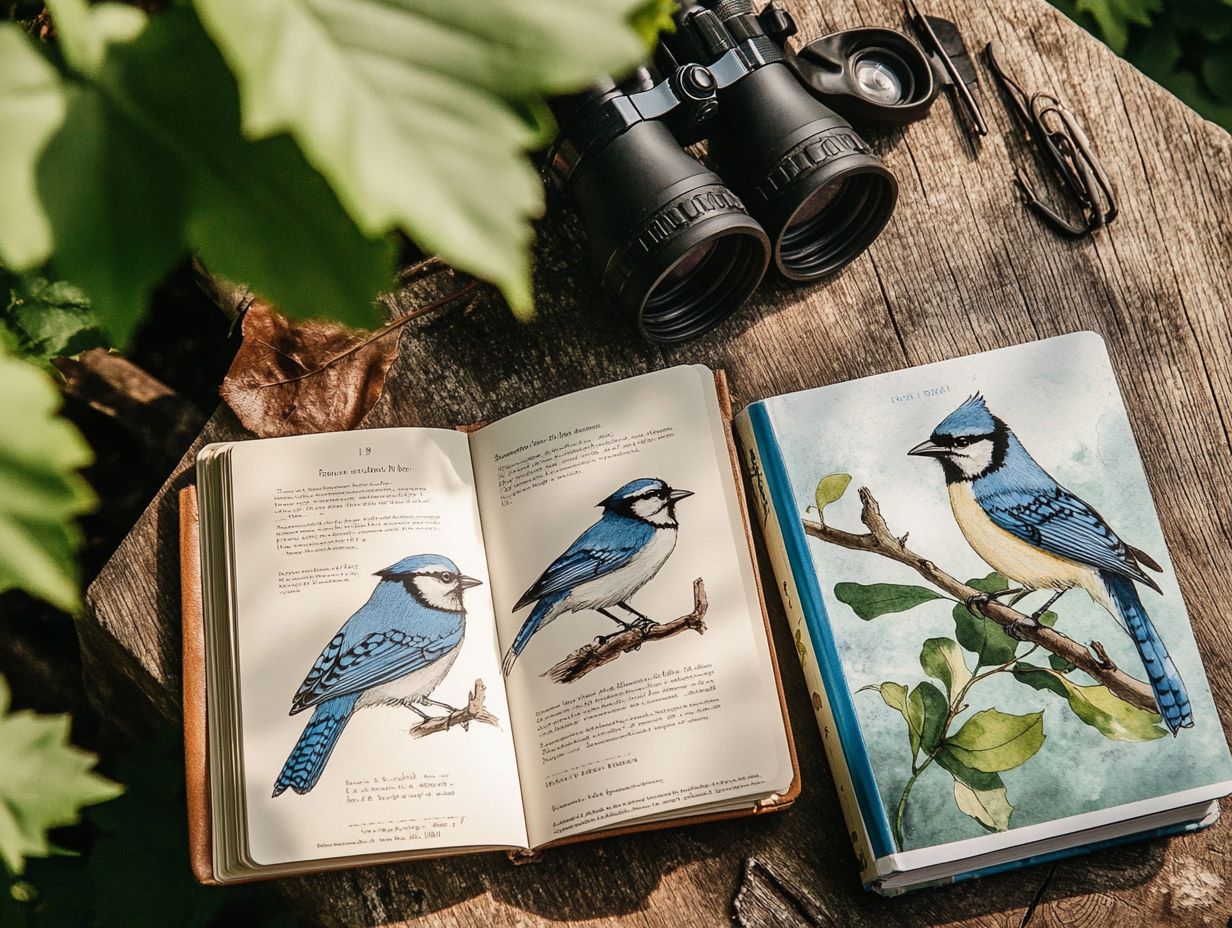
The Crossley ID Guide: Eastern Birds transforms the conventional field guide format. It incorporates innovative presentation techniques and features multiple images of birds in their natural habitats to assist you in accurate identification.
This guide immerses you in the vibrant context of avian behavior. By offering varied perspectives and scenarios, you can readily recognize the traits and patterns that define each species.
To make the most of this guide in the field, actively compare the diverse illustrations with your live sightings. Paying attention to habitat details will deepen your understanding and appreciation of the birds.
This fosters a richer connection with nature, making each birding experience more rewarding.
8. The Warbler Guide
The Warbler Guide is an invaluable resource for birdwatchers dedicated to the elusive task of identifying warblers. With detailed illustrations and vocalizations at your fingertips, you ll achieve accurate identification.
These stunning birds often hide in dense foliage, making them tricky to spot. This guide boldly tackles the challenges of spotting these beautiful birds!
You ll appreciate the colored visual aids, complete with insights on habitat and behavior. This provides you with a well-rounded understanding of each species.
The included call notes serve as your auditory reference, helping you recognize warbler songs and calls essential for pinpointing their presence.
By blending both visual and aural elements, this resource will supercharge your identification skills, making every birding trip exhilarating!
9. The Sibley Field Guide to Birds of Eastern North America
The Sibley Field Guide to Birds of Eastern North America is your compact yet comprehensive resource for birdwatching in the region. For those looking to expand their collection, exploring regional bird field guides you need to own can enhance your adventures in the great outdoors with detailed illustrations and essential identification tips.
This guide meticulously focuses on Eastern species, making it an invaluable companion as you explore the diverse avifauna of the area.
Its practical layout is user-friendly, allowing you to reference information quickly in the field. You can easily identify birds while on the go.
This version distills essential information into a portable format that fits perfectly in your backpack or pocket. Whether you’re a novice or an experienced observer, the relevance of this guide is undeniable.
10. The Kaufman Field Guide to Advanced Birding
The Kaufman Field Guide to Advanced Birding elevates your skills by exploring the detailed differences in birdwatching. As a seasoned birdwatcher, you ll discover advanced techniques and insights to enhance your field skills and enjoyment of this rewarding hobby.
By integrating detailed behavioral observations and highlighting the significance of contextual habitat factors, this guide helps you interpret avian behaviors effectively.
It acts as a manual for refining your identification skills and as a resource that expands your understanding of the study of birds and their environment.
With a fusion of meticulous illustrations and expert commentary, this guide encourages you to observe closely and ask deeper questions. Cultivate a more holistic approach to your birdwatching pursuits!
Grab your guide and head outside to start discovering the wonders of birdwatching today!
11. The National Audubon Society Field Guide to Birds: Eastern Region
The National Audubon Society Field Guide to Birds: Eastern Region is a critical resource for bird enthusiasts like you. For those looking to expand their knowledge, exploring popular bird field guides among experienced birders can further enhance your birdwatching experience. With its user-friendly layout, it emphasizes the importance of identifying and conserving local bird species.
This guide not only helps you recognize the different types of birds around you but also highlights the urgent need to protect their natural habitats, including wetlands, forests, and grasslands. It focuses on specific Eastern species, such as the American Woodcock and the Red-shouldered Hawk, showcasing their unique roles in the ecosystem.
With enhanced features like stunning photographs and detailed range maps, this guide is accessible to everyone. Whether you re just starting or have years of experience, this guide is your key to unlocking the wonders of birdwatching!
By offering practical information on how you can contribute to conservation efforts, it fosters a deeper connection between you and your feathered neighbors, promoting awareness and inspiring action for a more sustainable future. Join the movement to protect our beautiful birds!
12. The Stokes Field Guide to the Birds of North America
The Stokes Field Guide to the Birds of North America presents a thorough exploration of the continent’s avian diversity. It merges stunning illustrations with practical identification tips tailored for birdwatchers at any skill level.
What elevates this guide above others is its meticulously organized layout. You can effortlessly find information on various species without feeling inundated.
Each section is distinctly defined, making it easy to discover details about specific birds, whether you’re just starting out or are a seasoned expert. This resource not only offers depth but also guarantees accessibility through clear language and engaging visuals.
You ll find that it enriches your birdwatching experience by seamlessly blending artistry with essential knowledge. Get ready to explore and appreciate the vibrant birdlife of North America!
13. The Peterson Field Guide to Warblers
The Peterson Field Guide to Warblers and The Warbler Guide: A Field Guide to Warblers of North America is your go-to resource for identifying the vibrant and diverse warbler species scattered across North America. With its detailed illustrations and insightful descriptions, this guide truly enhances your birdwatching experience.
Not only does it showcase a wide array of warbler species, it also arms you with essential tips for effective field observation. It addresses the unique challenges of spotting these small, often elusive birds.
By highlighting key visual traits like plumage patterns, markings, and vocalizations, you can differentiate similar species. With its helpful visual aids, you can quickly reference important information while out in the field.
Whether you re maneuvering through dense shrubbery or scanning the tree canopies, you’ll find practical advice for sharpening your observational skills. This guide is an invaluable companion on all your outdoor excursions!
14. The Sibley Guide to Bird Life and Behavior
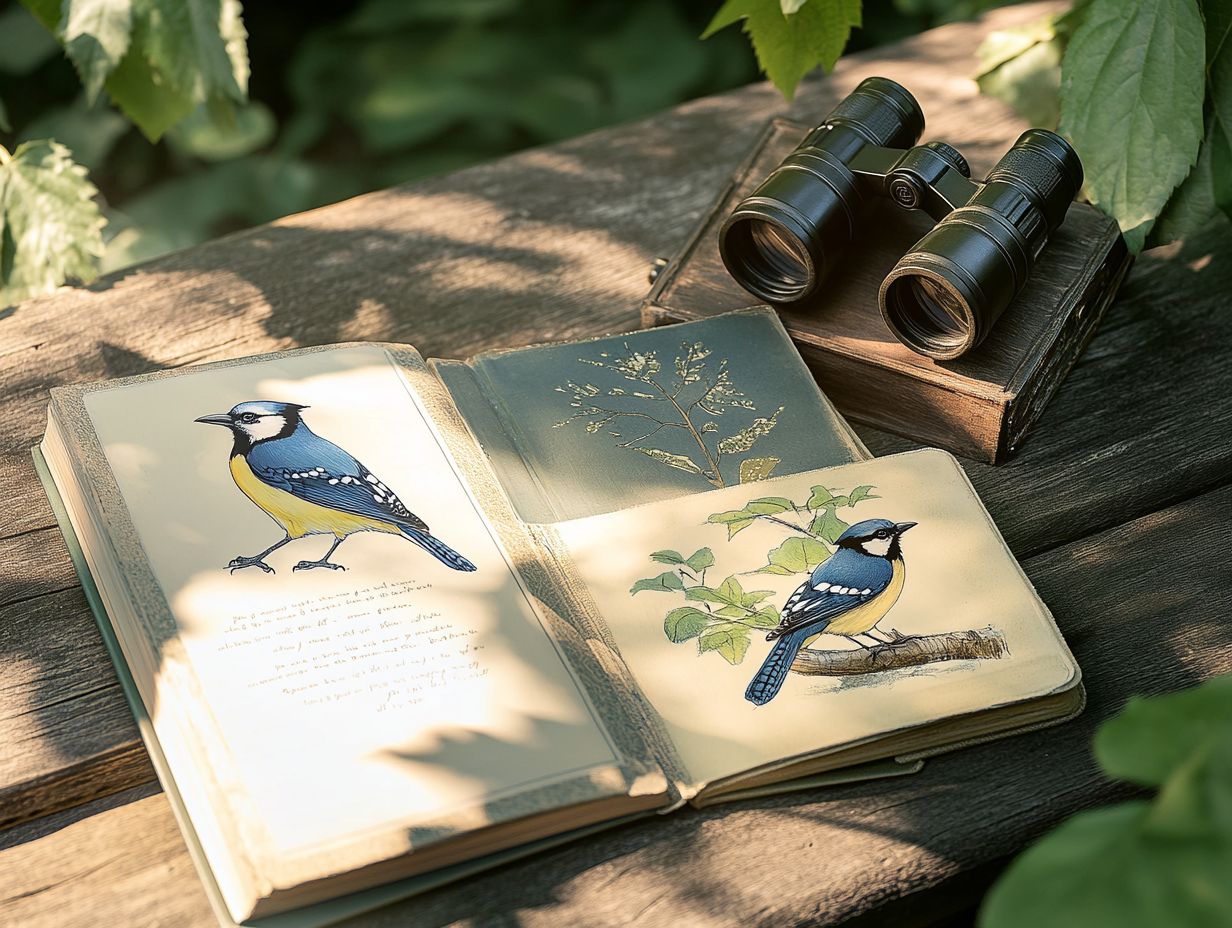
The Sibley Guide to Bird Life and Behavior offers you an immersive exploration of the captivating behavioral patterns and life cycles of various bird species. This invaluable resource not only acts as a comprehensive identification tool but also delves into the intricate relationships and behaviors that characterize avian life.
By examining elements such as courtship rituals, migratory patterns, and feeding strategies, you can cultivate a deeper appreciation for these remarkable creatures. The insights provided in the guide enable you to understand the context behind the birds actions, transforming each outing into a rich narrative rather than just a tally of sightings.
With a clearer understanding of the dynamics at play in avian life, you foster a stronger connection to nature. This significantly enhances your outdoor adventures. Grab your field guide today and start your birdwatching adventure!
15. The Kaufman Field Guide to Nature of New England
The Kaufman Field Guide to Nature of New England is your ideal companion for birdwatching and immersing yourself in the natural world. It offers detailed insights into the region s diverse birdlife and vibrant ecosystems.
Delving into this extensive resource allows you to explore the unique natural areas of New England, from its lush forests to its stunning coastal regions. This guide becomes a critical tool as you navigate these rich habitats. With insightful descriptions and striking photographs, it aids you in identifying a variety of bird species while deepening your understanding of the intricate relationships between flora and fauna.
Whether you re observing migratory patterns the way birds move between different places during different seasons or local nesting behavior, you ll come to appreciate how the region’s distinct environments nurture an abundance of wildlife, enriching your birdwatching adventures.
What Are the Key Features to Look for in a Field Guide?
When selecting a field guide for birdwatching, you should carefully consider several key features that will elevate your identification skills. Pay attention to the quality of photographs and illustrations, the ease of use, and the comprehensiveness of species coverage.
A guide filled with high-resolution images and clear illustrations will make it much easier for you to differentiate between similar species, ensuring you can confidently recognize what you see. Well-organized guides whether by habitat, color, or size make identification easier, especially for beginners.
It’s also essential to seek out in-depth information about behaviors, calls, and migratory patterns, as this knowledge can significantly enrich your birdwatching experience. For those just starting, selecting a guide that focuses on local bird species and features user-friendly tabs or indexing can greatly enhance your learning curve and enjoyment in the field.
How to Use a Field Guide Effectively?
To use a field guide effectively, first familiarize yourself with its layout, utilize the index for quick reference, and learn to discern the critical field marks that distinguish various bird species.
Understanding how the guide is organized can significantly enhance your ability to locate specific species swiftly. Take the time to study sections that categorize birds by habitat, size, and color, allowing for a more intuitive searching experience.
Be mindful of the season, as many birds migrate, altering what you might observe in a particular area. For example, if you find yourself in a park during spring, you ll want to look for those brightly colored warblers, making it useful to consult the seasonal guides.
Pay attention to behaviors like feeding habits or flight patterns, which provide essential context that aids in identification. In this way, field guides become invaluable tools for any birding enthusiast.
What Are the Benefits of Using a Field Guide for Bird Watching?
Using a field guide for birdwatching brings a wealth of benefits, including sharper identification skills, an enhanced appreciation for avian diversity, and a deeper understanding of bird behavior and their habitats.
But it doesn t stop there; such a guide transforms your entire birdwatching experience by igniting genuine curiosity about the local wildlife. You ll forge an exciting connection to your environment, often leading to a heightened awareness of the importance of conservation.
As you wander through parks, forests, or even your own backyard, the ability to identify various birds elevates your excitement and instills a sense of stewardship towards nature. This personal exploration can inspire you to advocate for habitat protection, nurturing both local ecosystems and your passion for ornithology.
How to Choose the Right Field Guide for Your Region?
Choosing the right field guides for bird watching in urban areas is essential for effective birdwatching. Local guides provide tailored information on species specific to your area and their unique habitats.
This is especially beneficial for both novice and experienced birders. It makes it easier to identify and understand the behaviors of local avian species. When selecting a guide, consider its geographic focus to ensure it highlights the birds commonly found nearby. It s also wise to choose guides that categorize birds by their habitats such as wetlands, forests, or grasslands. This can significantly enhance your birdwatching experience.
For beginners, a straightforward guide with clear visuals and common birds is ideal. Seasoned birders might find value in more detailed references featuring rarer species and advanced identification tips.
What Are Some Common Mistakes to Avoid When Using a Field Guide?
When using a field guide for birdwatching, it’s easy to make common mistakes that can dampen your identification efforts. Overlooking subtle field marks, rushing through your observations, and relying too much on memorization can all hinder your success.
It’s essential to take your time and observe the bird’s behavior, habitat, and vocalizations. Vocalizations, or bird calls, are sounds birds make to communicate. These details can provide invaluable clues. Don t rush your observations take the time to truly see! The excitement of spotting a new species is thrilling, but pausing to soak in the experience heightens your enjoyment and sharpens your accuracy in identifying the bird.
While field guides are fantastic tools, remember they should complement your active observation, not replace it. Relying only on printed descriptions can cause mistakes in identification. Instead, blending the guides with a keen awareness of your surroundings will give you a more comprehensive approach.
Practicing patience and staying adaptable during your outings can transform common oversights into remarkable moments of discovery.
Frequently Asked Questions
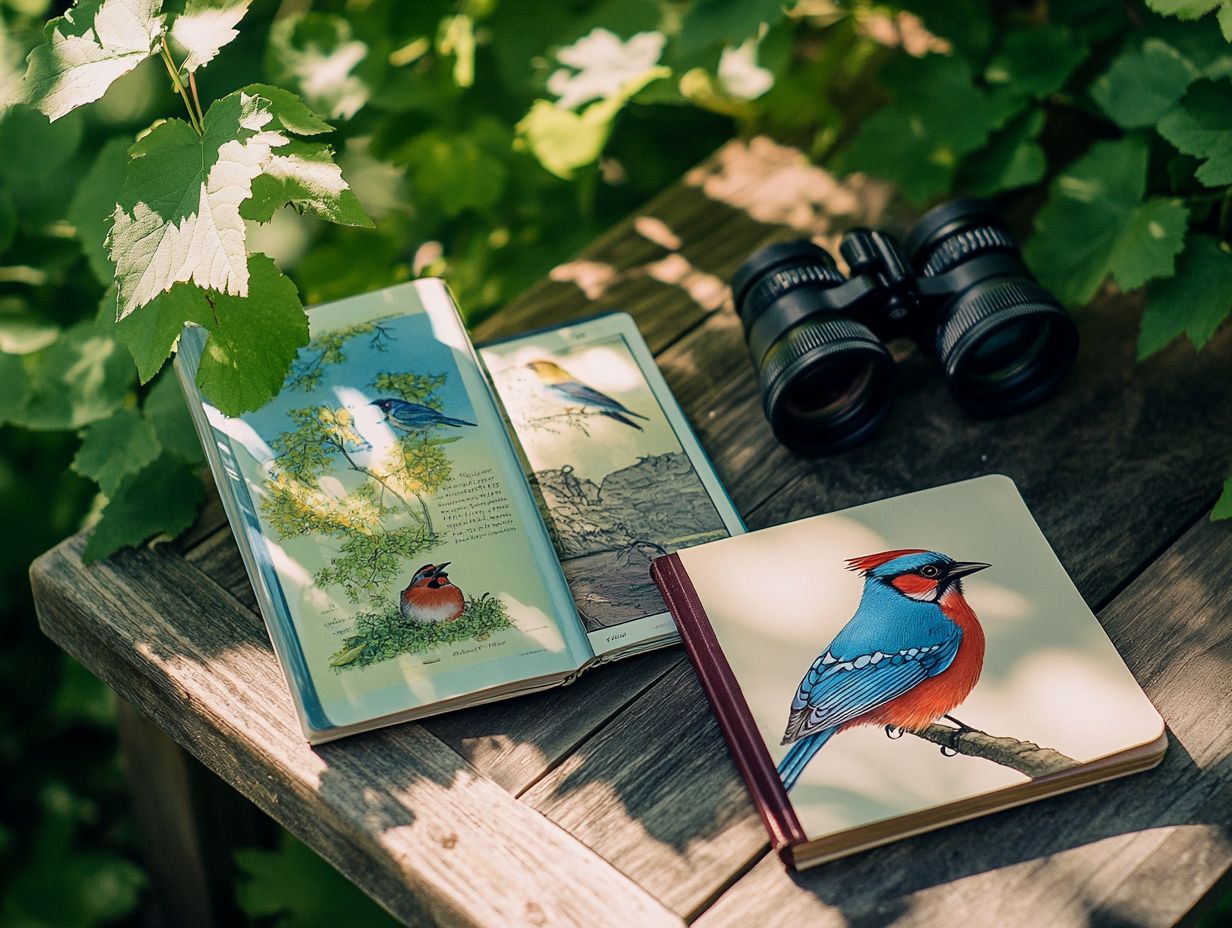
Curious about the best field guides? Here s what you need to know!
Some popular field guides for attracting backyard birds include “National Geographic Field Guide to the Birds of North America,” “The Sibley Guide to Birds,” and “Peterson Field Guide to Birds of Eastern and Central North America.”
Do I need a field guide to identify birds in my backyard?
While it’s not necessary, a field guide for Eastern U.S. birds can be a helpful tool for identifying birds in your backyard. It provides detailed information and illustrations to help you accurately identify the species.
Are there any free field guides available for backyard birds?
Yes, some free online resources can help you identify backyard birds. The Cornell Lab of Ornithology’s “Merlin Bird ID” app and the Audubon Society’s “Bird Guide” app are both available for free and offer comprehensive guides for identifying birds.
What should I look for in a good field guide for birds in my backyard?
A good field guide should have clear and detailed illustrations or photographs, information on the bird’s physical characteristics, range, and habitat, and tips for identifying similar species. It should also be organized for easy navigation and understanding.
Can I use a field guide for bird identification in other locations besides my backyard?
Yes, many field guides cover a wide range of species found in different regions. However, it’s important to note that some species may only be found in specific areas, so it’s best to use a field guide that is specific to your location for the most accurate identification.
Are there any field guides specifically for children to use in identifying backyard birds?
Yes, several field guides are designed for children, such as “National Geographic Kids Bird Guide of North America,” “The Young Birder’s Guide to Birds of North America,” and “Backyard Birds: An Introduction to Familiar North American Species.” For those interested in more advanced resources, exploring the best bird field guides for coastal regions can also enhance the bird identification experience. These guides often use simpler language and colorful illustrations to make bird identification fun and accessible for children.





